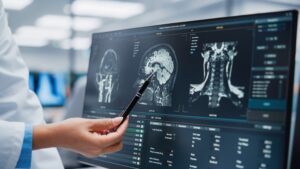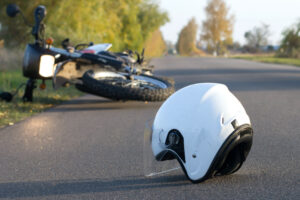The primary purpose of motorcycle and bicycle helmets is to protect riders in the event of an accident. However, even well-made helmets can crack if the accident victim strikes the ground with significant force. Consequently, victims may suffer serious head injuries – including concussions or comas – even while wearing a helmet in a collision.
If you or someone you love suffered head injuries in a motorcycle or bicycle accident due to a motorist’s negligence, you need to consult an experienced injury attorney right away. Your lawyer can review the facts of your accident with you, investigate the accident circumstances, and obtain a copy of the police report and other relevant documentation. Your motorcycle and bicycle accident lawyer in Phoenix may then file a claim with the at-fault party’s insurance company, negotiate on your behalf, and pursue the full settlement or litigation compensation you deserve for your head injury.
How Can Cyclists Suffer a Head Injury While Wearing a Helmet?
Wearing a helmet is a crucial safety measure for motorcyclists and bicyclists, but it doesn’t guarantee complete protection against head injuries in accidents resulting from someone else’s negligence. Even with a helmet, certain factors contribute to the risk of head injuries during such incidents. First, the impact force during a collision can still transmit through the helmet, leading to head injuries. Helmets are designed to absorb and distribute the force of an impact, but they have limitations. High-speed collisions or accidents involving heavy vehicles, such as large commercial trucks, may exert forces beyond the helmet’s protective capacity.

Secondly, the angle and direction of impact play a role. Helmets primarily safeguard against direct blows to the top or sides of the accident victim’s head. However, in accidents, impacts can occur at various angles, leading to rotational forces that the helmet may not fully mitigate. These rotational forces can cause internal brain injuries, even with a helmet in use. Thirdly, helmet fit and quality matter. Poorly fitting helmets, or those not meeting safety standards, may compromise their effectiveness. A properly fitted, certified helmet provides better protection, but it is not infallible – especially in a forceful collision that knocks a cyclist to the ground. Additionally, helmets do not shield the rider’s face or jaw. In accidents, facial injuries or fractures can occur, contributing to overall trauma. Moreover, helmets may not prevent concussions, as they primarily focus on preventing more severe head injuries. Concussions can result from the victim’s brain moving within their skull, and helmets may not completely eliminate this risk. Overall, motorcycle and bicycle helmets provide riders with essential protection, but they have limitations in preventing all head injuries – especially during accidents that result from someone else’s negligence. If you suffered a head injury in a recent accident, your lawyer can thoroughly investigate the circumstances and determine your eligibility for filing a personal injury claim or lawsuit.
Most Common Causes of Motorcycle and Bicycle Accidents
Motorcycle and bicycle accidents resulting in head injuries often share common causes, emphasizing the need for increased safety and awareness by others. One prevalent factor is the failure of other motorists to detect and yield to motorcyclists and bicyclists. Drivers frequently overlook motorcycles and bicycles, especially during turns or lane changes, leading to collisions and potential head injuries.
Another significant cause is distracted driving. When motorists engage in activities like texting, talking on the phone, or adjusting their devices while driving, their attention diverts away from the road. This distraction can result in collisions with motorcycles and bicycles, posing a heightened risk of head injuries due to the vulnerability of these road users.

Unsafe lane changes and failure to signal are also frequent contributors to accidents involving motorcycles and bicycles. Sudden maneuvers by other vehicles, without proper indication, can catch motorcyclists and bicyclists off guard, leading to collisions and head injuries. Insufficient awareness of blind spots further increases this risk.
Speeding is another leading cause of motorcycle and bicycle accidents, increasing the severity of injuries when collisions occur. The higher impact forces associated with speeding incidents increase the likelihood of head injuries for motorcyclists and bicyclists. Reduced reaction time and limited control further compound these risks.
Additionally, intersections pose a significant risk for motorcycle and bicycle accidents. Drivers failing to yield the right-of-way, running red lights, or misjudging the speed of oncoming motorcyclists or bicyclists contribute to a high number of accidents. Intersections become particularly hazardous zones for head injuries when these failures in judgment lead to collisions.
Finally, driving under the influence of alcohol or drugs is a significant factor in motorcycle and bicycle collisions. Impaired motorists are more likely to make critical errors, posing a danger to themselves and others on the road. Motorcyclists and bicyclists involved in accidents with impaired drivers face an increased risk of head injuries due to the forceful nature of these collisions.
If you suffered a head injury in one of these types of motorcycle or bicycle accidents, an experienced injury lawyer can go over your options and file a claim with the at-fault driver’s insurance company.
How to Legally Prove the Elements of Motorcycle and Bicycle Accidents
To legally establish a motorcycle or bicycle accident case resulting from someone else’s negligence, injured cyclists must prove several key elements. The first element is duty, demonstrating that the at-fault motorist (or defendant) owed the injured cyclist (or plaintiff) a legal duty of care. This typically involves illustrating that the defendant had a responsibility to drive safely and adhere to traffic laws.
The second element is a breach of duty, indicating that the defendant failed to meet their duty of care. This may involve violating traffic regulations, engaging in distracted driving, or exhibiting reckless behavior. The plaintiff must present evidence showcasing the defendant’s failure to uphold their duty and the direct connection to the accident.

Causation is the third element, establishing a clear link between the defendant’s breach of duty and the injuries that the plaintiff suffered. It involves demonstrating that the negligent actions of the defendant were a substantial factor leading to the accident and subsequent harm. This requires evidence connecting the defendant’s conduct to the injuries that the motorcyclist or bicyclist sustained.
The fourth element is damages, illustrating the actual harm the plaintiff suffered due to the accident. This includes physical injuries, medical expenses, property damage, and pain and suffering. Documentation such as medical records, repair bills, and income statements can help substantiate the extent of the plaintiff’s damages.
To prove these elements effectively, collecting and preserving evidence is crucial. This involves gathering accident reports, witness statements, photographs, and any available video footage. These pieces of evidence can help to establish the events leading up to the crash, the defendant’s actions (or inactions), and the aftermath of the collision.
Eyewitness testimonies also play a significant role in supporting the plaintiff's case. Statements from individuals who observed the accident can provide valuable perspectives on what transpired, helping to establish the defendant’s breach of duty and the resulting harm.
Expert testimony may also be necessary to strengthen the case further. Accident reconstruction specialists or medical professionals can provide insights into the mechanics of the accident or the extent of the plaintiff’s injuries, aiding in establishing causation and damages.
Keeping a detailed record of medical treatments, rehabilitation, and related expenses also strengthens the plaintiff’s claim for damages. Additionally, maintaining a journal documenting the physical and emotional effects of the injuries can help to showcase the pain and suffering that the plaintiff endured.
By methodically presenting evidence to address each legal element – duty, breach of duty, causation, and damages – a motorcycle or bicycle accident victim significantly increases their likelihood of recovering a favorable monetary award for their accident-related losses.
Recovering Damages Following a Motorcycle or Bicycle Accident
Accident victims who suffer head injuries in motorcycle or bicycle accidents may be eligible for various damages. One significant category is medical expenses, encompassing the costs associated with immediate and ongoing medical treatments. This includes hospital bills, surgeries, rehabilitation, prescription medications, and any necessary assistive devices. Victims can seek compensation not only for past medical expenses but also for anticipated future medical needs related to their head injuries.
Lost income represents another crucial element of damages. When head injuries force victims to take time off from work, they can pursue compensation for the income they would have earned during that period. Additionally, if the injuries result in a diminished capacity to work or a permanent disability, victims may seek damages for the effect on their future earning potential.

Property damage is relevant when the accident results in harm to personal belongings, such as helmets, bicycles, or motorcycles. Compensation can cover the repair or replacement costs for damaged property, helping victims recover from the financial losses they incurred in the accident.
Pain and suffering, which are non-economic damages, address the physical and emotional distress that the victim experienced due to their head injury. This category includes compensation for pain, anxiety, depression, and overall reduction in quality of life resulting from the accident.
In some cases, victims may be eligible for damages related to loss of consortium. This refers to the effect of the head injury on the victim’s relationships and companionships with others. Spouses or family members may seek compensation for the loss of emotional support, companionship, and care resulting from the accident-related head injuries.
To recover these damages, it’s crucial for accident victims to gather and present evidence supporting their claims. This includes medical records, receipts, employment documentation, and any other relevant information that can help to establish the extent of their damages. An experienced motorcycle accident lawyer can aggressively advocate on your behalf during settlement negotiations or litigation to maximize the amount of compensation you ultimately recover in your case.
What Happens During Litigation?
Bicycle and motorcycle accident litigation involves several key steps to determine responsibility and seek compensation for injuries. After filing a lawsuit, the process begins with discovery, where both parties exchange information and evidence. This includes collecting documents, interviewing witnesses, and building a comprehensive case to support the injured party’s claims.
Following discovery, the parties may explore settlement options through negotiation or alternative dispute resolution (ADR) methods like mediation or arbitration. In mediation, a neutral third party helps facilitate settlement discussions between the parties to reach a mutually agreeable resolution, while binding arbitration involves presenting the case to an arbitrator who reaches a final decision in the case. These ADR approaches aim to resolve the dispute without the need for trial, potentially saving significant time and resources for everyone involved.
If a settlement isn't reached or accepted, the case proceeds to trial. Before trial, the attorneys engage in pretrial motions, requesting the court to make legal rulings or decisions that may affect the case outcome. This phase also helps to address any outstanding legal issues and streamline the trial process.
During the trial, both parties present their arguments, witnesses, and evidence to the judge or jury. The injured party typically goes first, outlining the case and presenting evidence to support their claims. The defendant then has the opportunity to present their defense. The judge or jury assesses the evidence and decides the verdict based on the facts and evidence that the parties presented. If the injured cyclist succeeds, the judge/jury determines the compensation to award for their head injury and other accident-related losses.
It's important to note that not all cases go to trial since many are resolved through settlements at various stages of litigation. Strong legal representation, thorough evidence gathering, and effective communication all contribute to achieving a full and fair result in motorcycle or bicycle accident litigation.
Speak with an Experienced Accident Lawyer Today about Your Recent Motorcycle or Bicycle Accident

If you recently sustained a head injury in a motorcycle or bicycle accident that a negligent driver caused, you may have legal options to consider. An injury attorney can evaluate your options and estimate the likely settlement or verdict value of your case. They can then advise you on the best course of action, including pursuing settlement negotiations or litigating your case to a resolution at a jury trial or ADR proceeding.